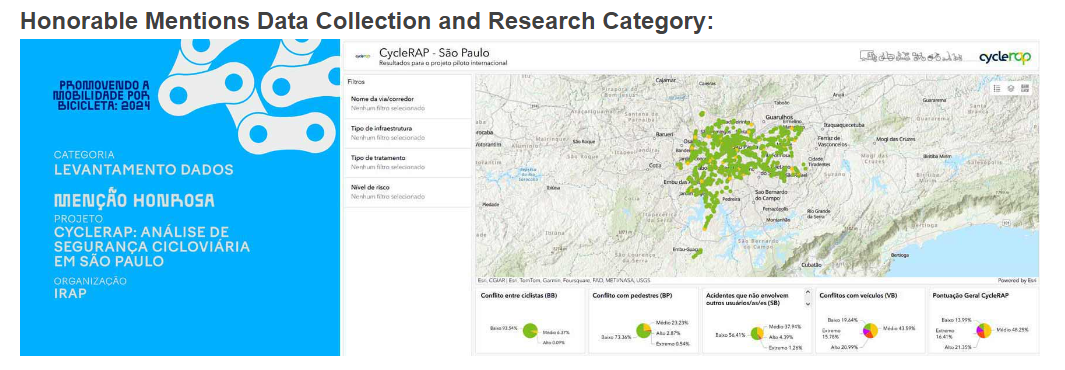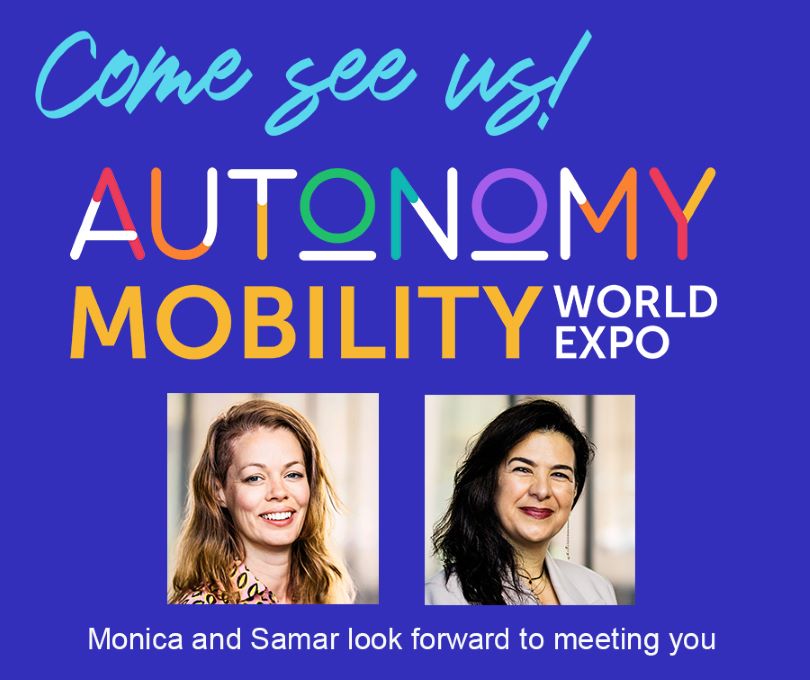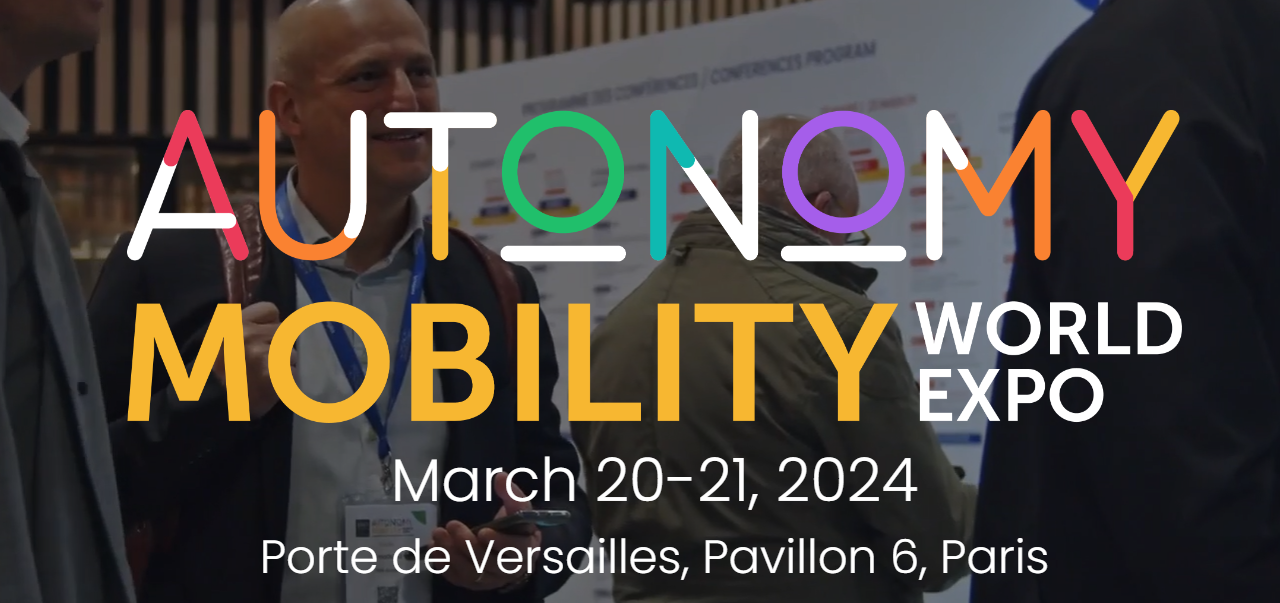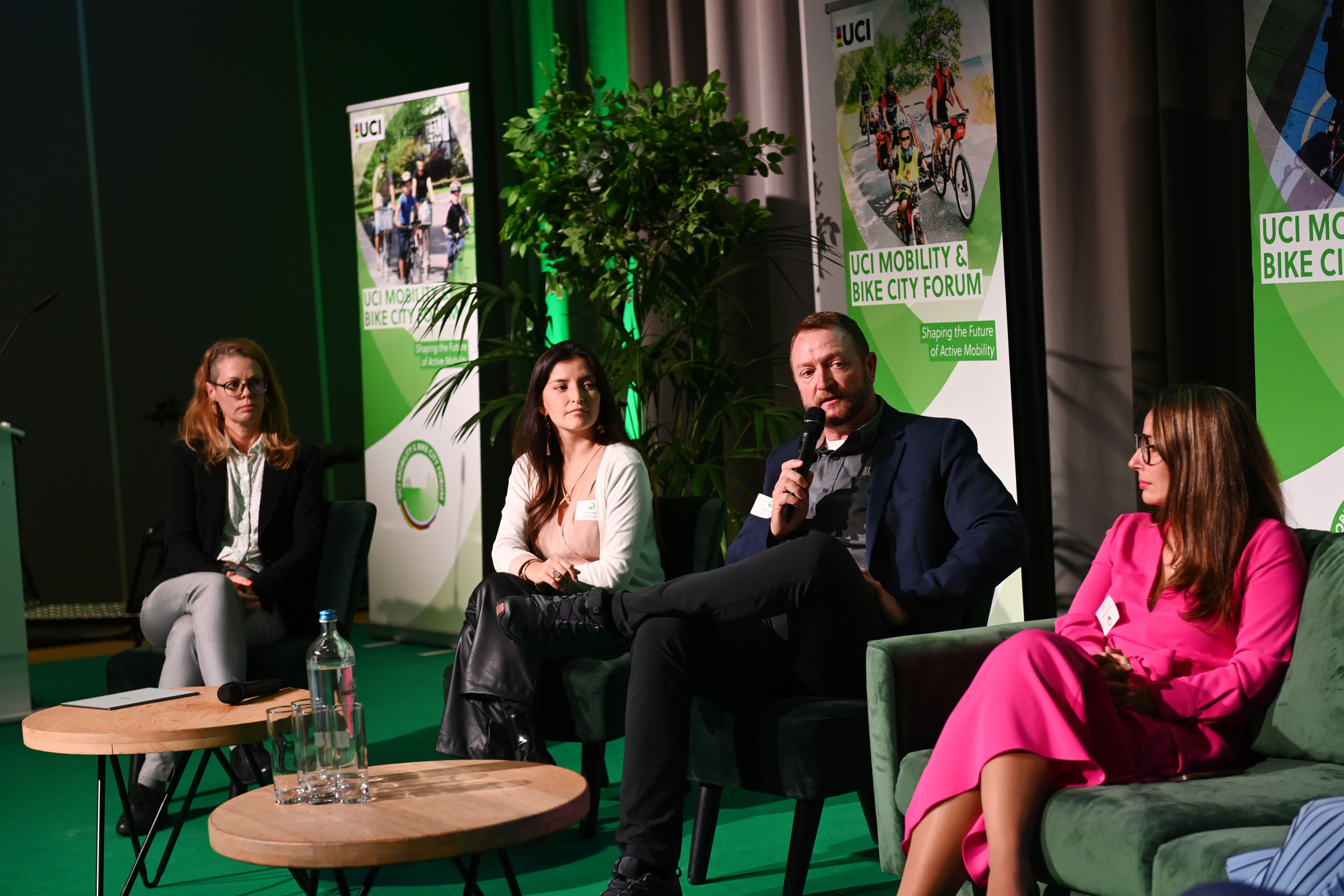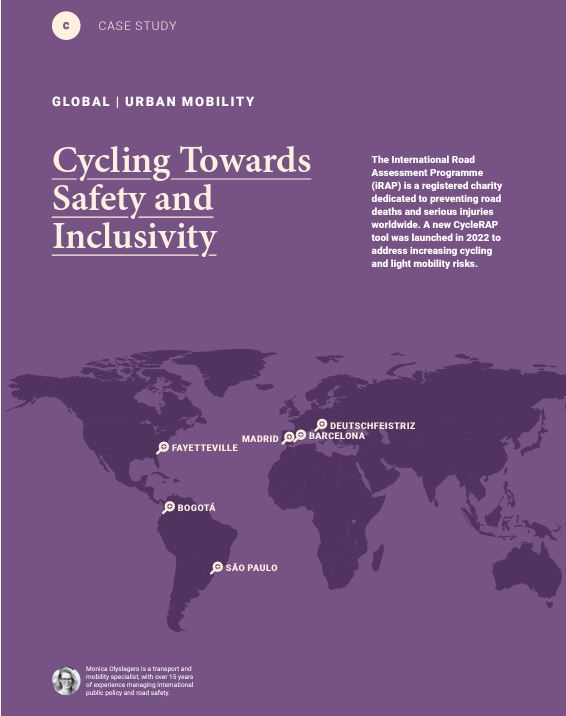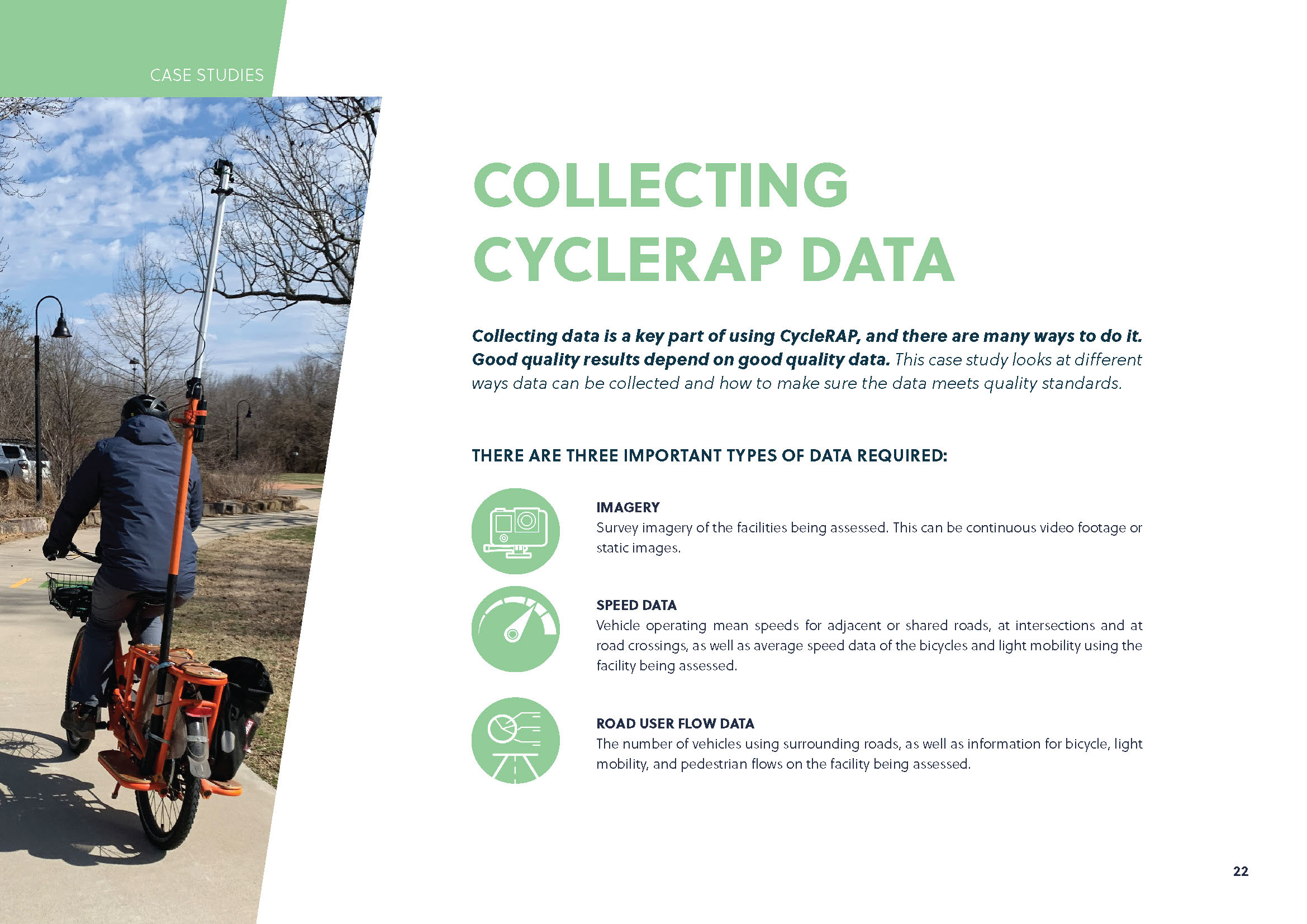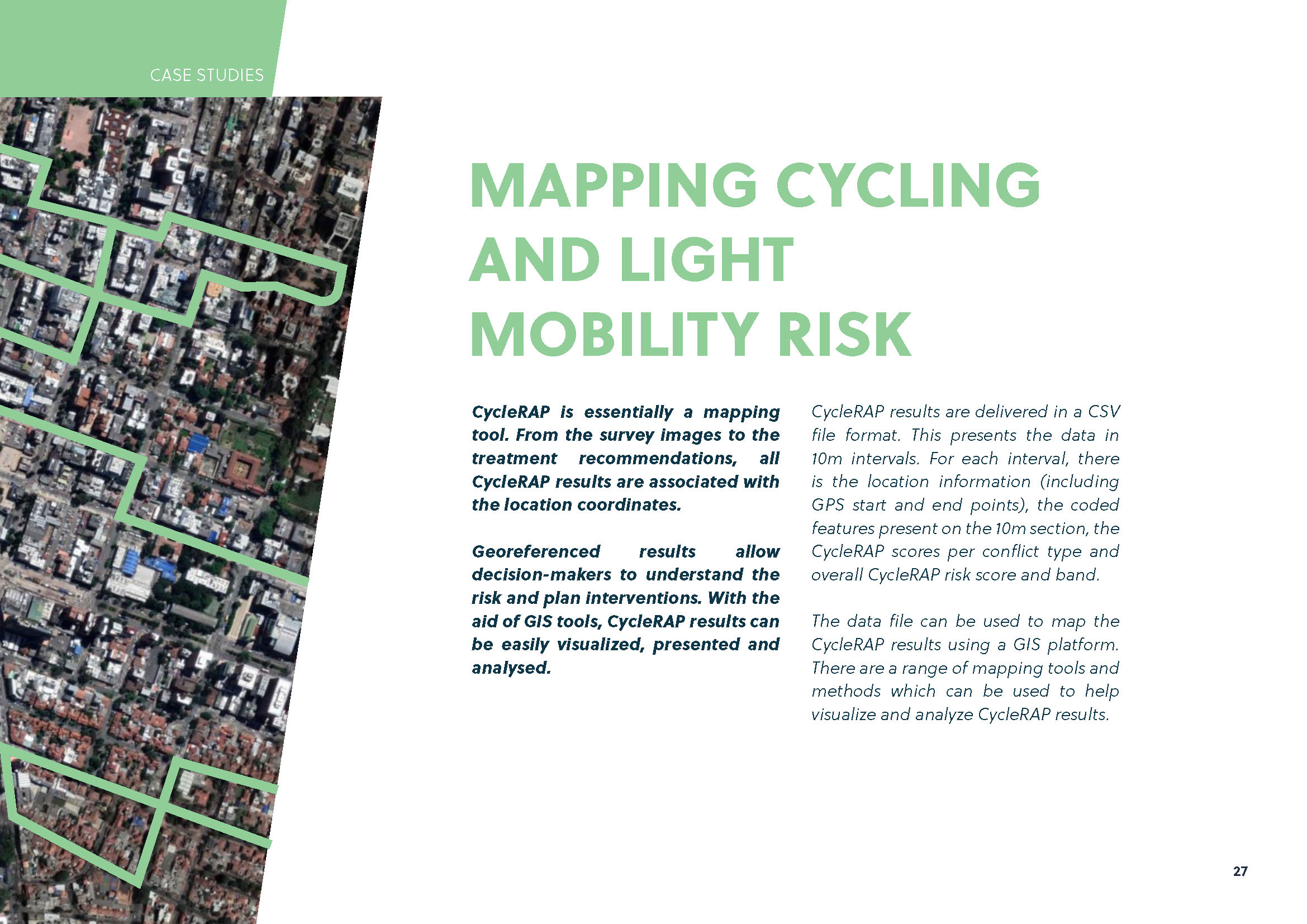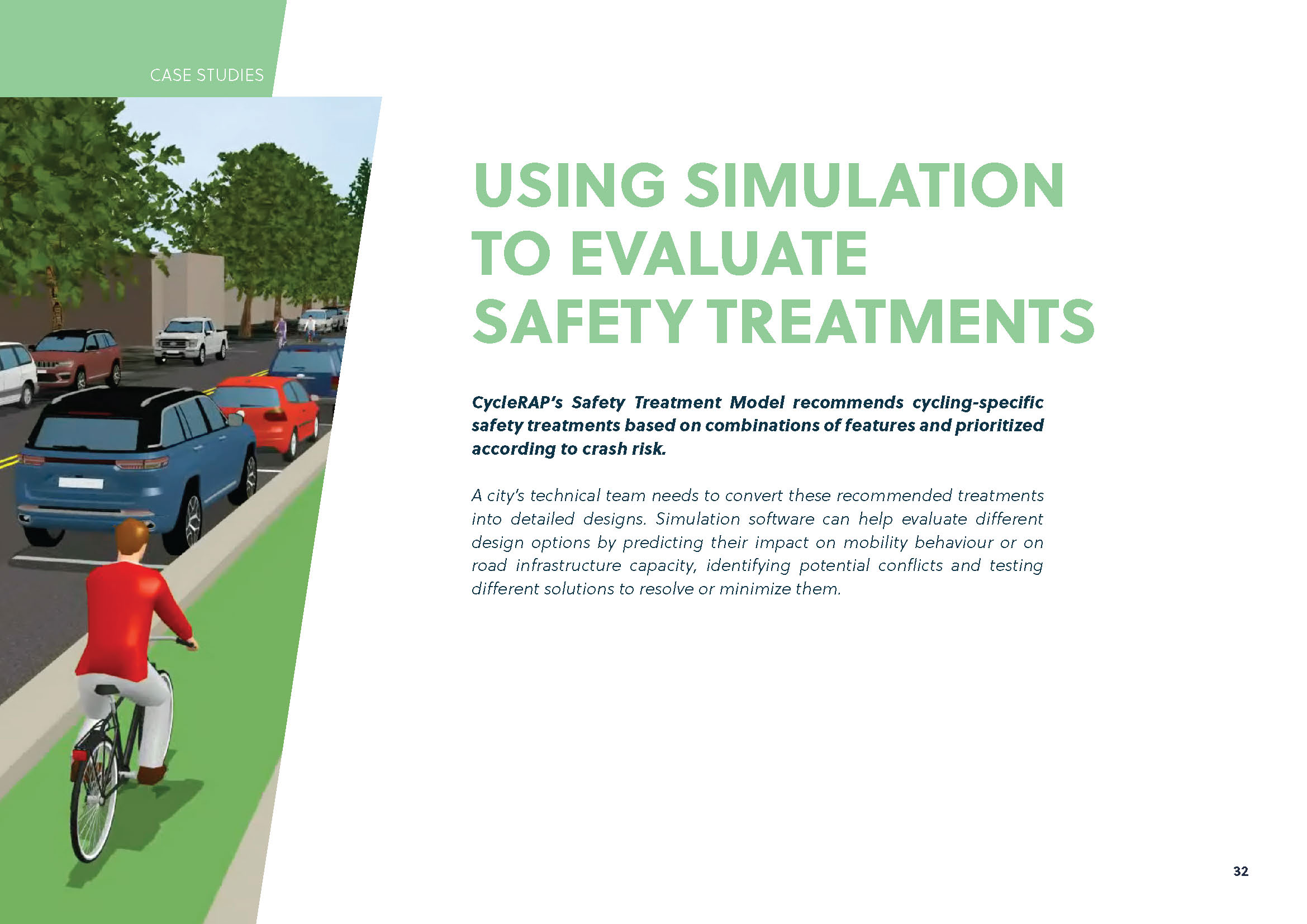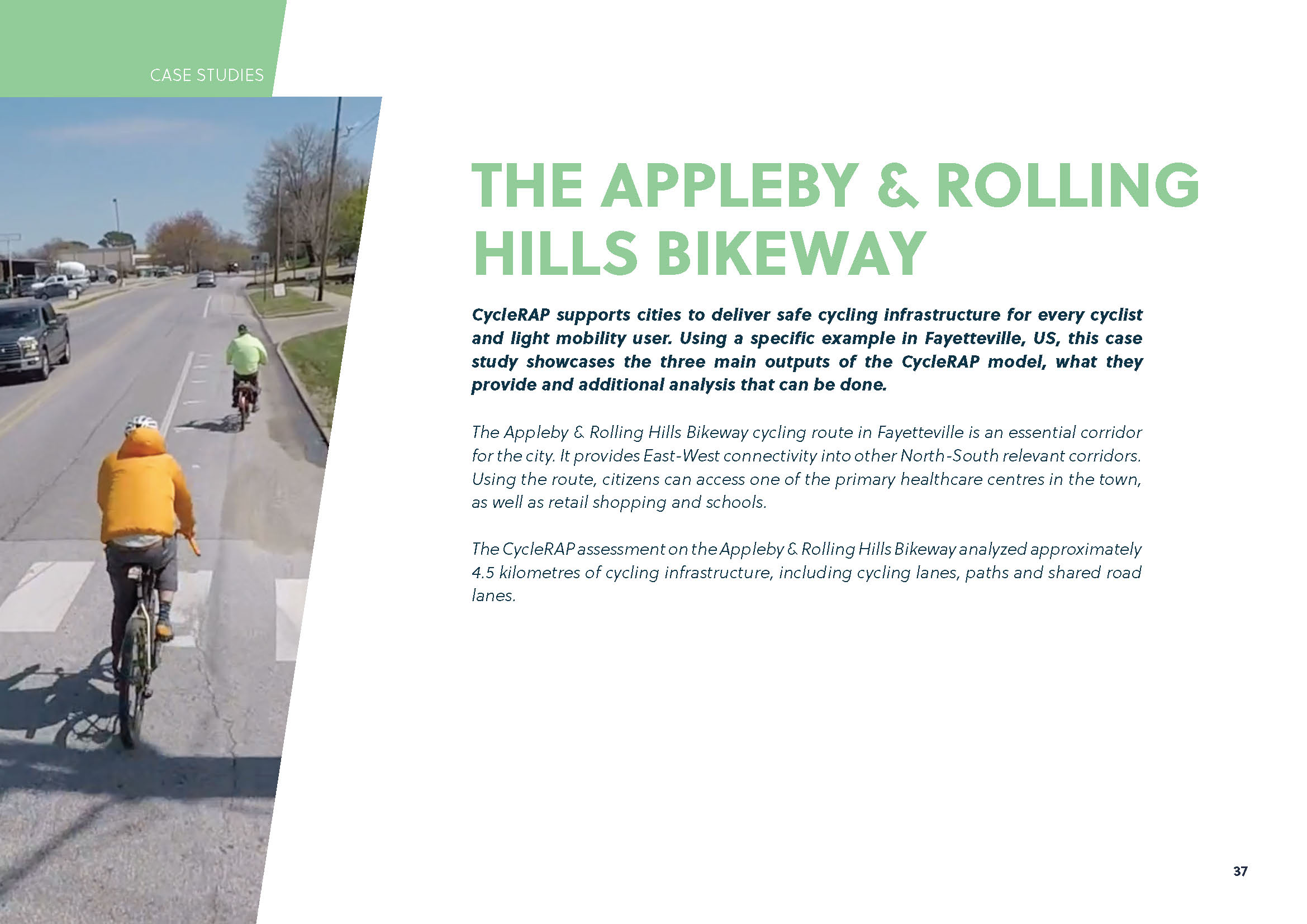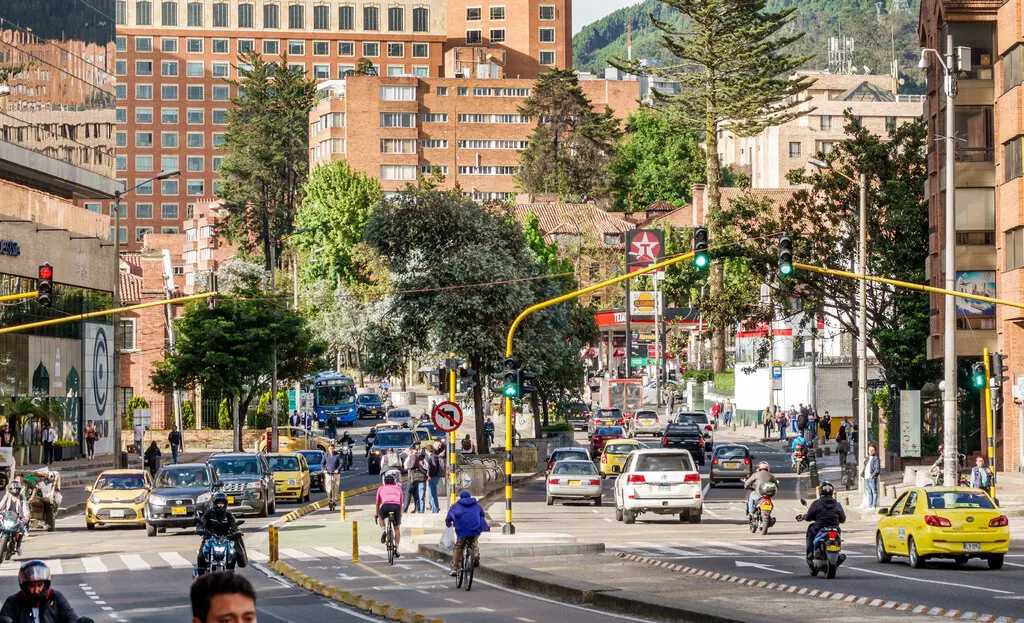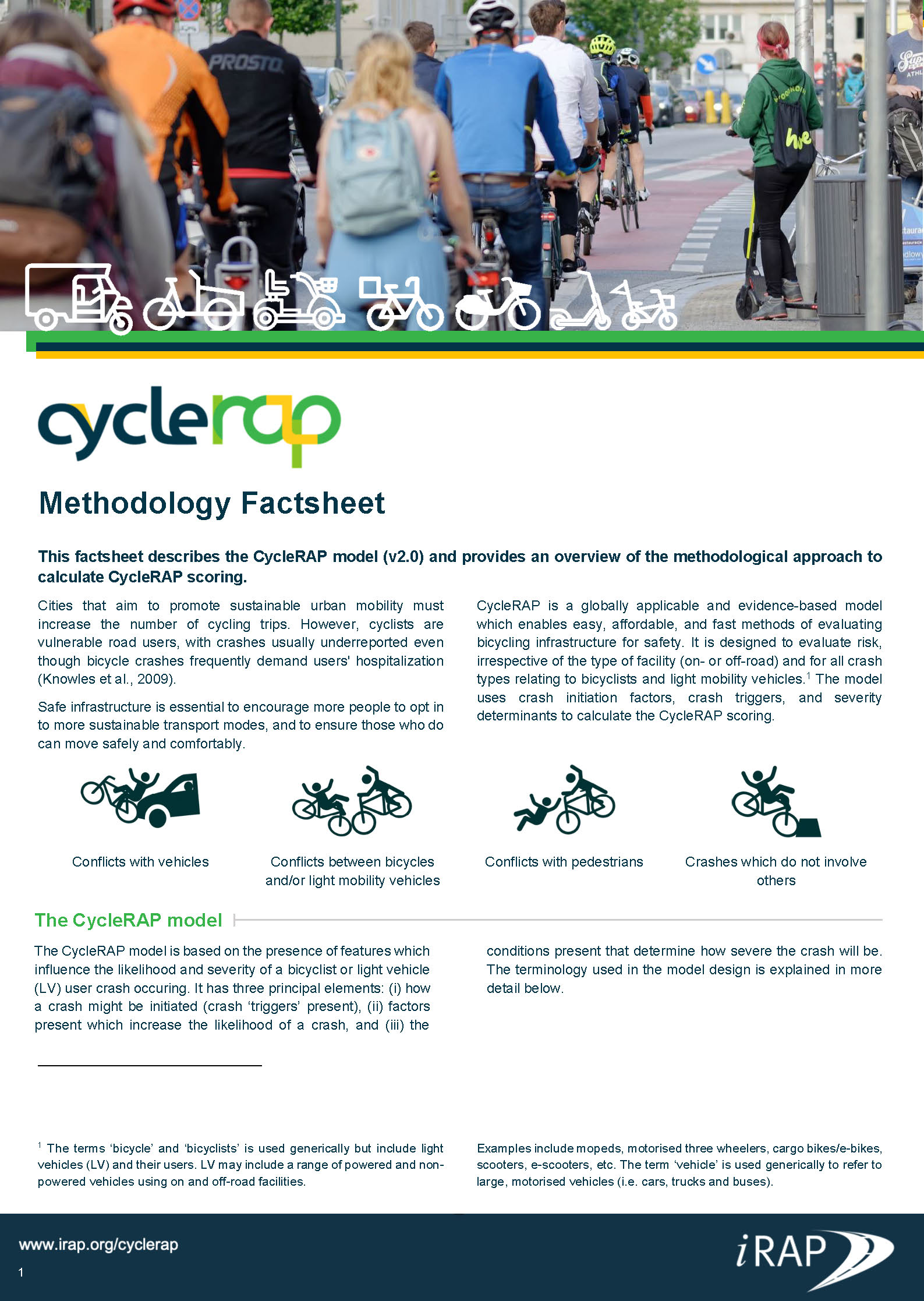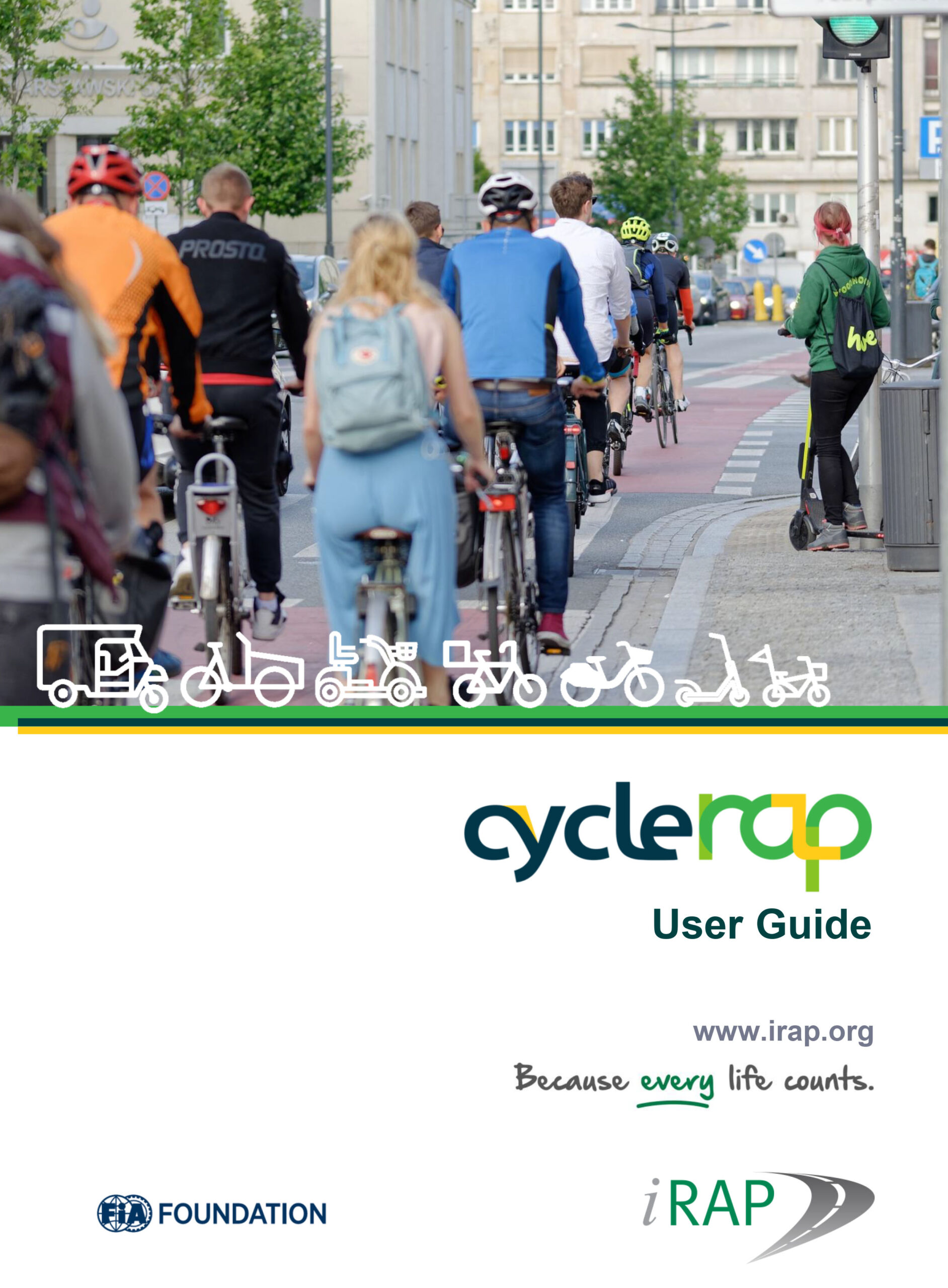
What is ‘CycleRAP’?
CycleRAP is an easy, affordable and fast method of evaluating road and bicycling infrastructure for safety. It aims to reduce crashes and improve safety specifically for bicyclists and other light mobility users by identifying high risk locations without the need for crash data.
Latest news
About
CycleRAP uses data about the features of a road, street or path to evaluate the risk of crashes for bicyclists and light mobility users—irrespective of the type of facility (or whether it is on or off road) and for all crash types. It can be used anywhere in the world.
CycleRAP is used to:
- Improve bicycling-related asset management and maintenance planning
- Help prioritise investment and planning for bicycle and light mobility modes, and
- Provide safety key performance indicators and track performance over time.
What problem does CycleRAP help solve?
Road safety is a critical issue which needs to be addressed to ensure that bicycling and light mobility options can continue to support new and greener mobility choices. The overall aim of CycleRAP is to reduce the risk of road crashes for bicyclists and those using other types of light mobility vehicles. Bicycles and light mobility vehicles do not have the same in-built protection large vehicles have. Therefore, safe infrastructure is critical.
Monitoring, managing and addressing safety on facilities used by bicyclists and light mobility vehicles is a challenge, even for those with the most advanced bicycling networks. Specifications and manuals for road engineering and design for bicycling infrastructure, assessment tools such as road safety audit, and road asset management practices often neglect or ignore safe bicyclist infrastructure. CycleRAP aims to help fill this gap by providing a way to objectively measure and benchmark safety.
Who can benefit from CycleRAP?
CycleRAP is designed to support transport authorities or other organisations involved in addressing or advocating for safer facilities for bicyclists and users of other light mobility vehicles.
Specific uses could be:
- Addressing explicit or general safety concerns for bicyclists and light mobility users
- Evaluating existing network’s capacity to cater for rapidly increasing demand or increase in new vehicle types
- Prioritise funding and investment into bicycling and light mobility infrastructure
- Assist cities formalising rapid response measures for bicyclists during COVID19.
The CycleRAP model and data is expected to be of interest to a wide range of stakeholders, including:
 |
 |
 |
 |
| Transport and urban planners | Bike share and micro mobility sharing service providers | Bicycle courier and food delivery companies | School communities |
 |
 |
 |
 |
| Policy makers and advocates for the environment, climate change and sustainability | Health services and insurance providers | Infrastructure and transport investors | Mapping and navigation providers |
How can I use CycleRAP?
If you would like to know more about using the CycleRAP model, contact iRAP or one of our Trusted Suppliers.
Governance
The CycleRAP model is owned and managed by iRAP. Its development and ongoing governance is guided by the CycleRAP Advisory Group. CycleRAP has benefitted from the generous support of the CycleRAP partners: ANWB, Fundacion Mapfre, UCI and PTV Group.
CycleRAP Advisory Group
A CycleRAP Advisory Group has been established to help guide the development of the CycleRAP model to ensure it can effectively underpin potential CycleRAP tools and applications and ultimately meet end user needs.
Membership is by invite only and aims to represent a range of skills, experience and expertise from across the world, including:
- Cycling safety experts and researchers
- iRAP-affiliated experts (such as Centres of Excellence and suppliers)
- Other organisations involved in road safety
- Potential CycleRAP suppliers.
The job of the Advisory Group is to:
- Peer review reports, model development and model documentation
- Attend update meetings and workshops to work through issues
- Inform the design of model outputs (e.g. risk scoring and safety treatment recommendations)
- Provide feedback on potential uses, pilot study opportunities and market analysis
- Review results from trials and pilot studies.
The CycleRAP Advisory Group members, all of whom generously volunteered their time and effort to the CycleRAP project, are:
| Name | Organisation |
| Aleksander Buczyński | ECF |
| An Volckaert | BRRC (Belgium) |
| Christoph Vollath | RACC (Spain) |
| Gert Jan Wijlhuizen | SWOV (The Netherlands) |
| Niek Prins | RHDHV |
| Peter Morsink | RHDHV |
| Magnus Larsson | VTI (Sweden) |
| Katja Kircher | VTI (Sweden) |
| Soufiane Boufous | UNSW (Australia) |
| Ben Beck | Monash University (Australia) |
| Kasem Choocharukul | Chula University (Thailand) |
| Alvin Poi Wai Hoong | MIROS (Malaysia) |
| Leonid Ljubotina | FPZ (Croatia) |
| Ramon Kienhuis | Keypoint Consultancy (The Netherlands) |
| Roxy Tacq | Urban Mobility & Road Safety Expert (Spain/The Netherlands) |
| Max McCardel | Safe System Solutions (Australia) |
| Pedro Homem de Gouveia | POLIS |
| Johan Diepens | Mobycon |
| Marc Figuls | Factual Consulting |
| Agnieszka Krasnolucka | FIA Foundation |
| Jolan Hulscher | Cyclomedia |
| Bas Brouwer | Cyclomedia |
| Gernot Sauter | 3M |
| Nathaly Torregroza Vargas | National Planning Department, Colombia |
| Flavio Soares | Ciclocidade |
Pilot projects
CycleRAP Pilot Project – Spain and from South to North America
The CycleRAP assessment will showcase the best practices of cycling infrastructure in 5 cities: Barcelona, Bogotá, Fayetteville, Madrid and São Paulo. Project end date: October 2023.

The CycleRAP model is being piloted as part of the Interreg SABRINA project to deliver safer bicycle routes across nine Danube area countries. To find out more, visit www.interreg-danube.eu/sabrina

Assessment of Via di Porta Cavalleggeri
CycleRAP helped Rome municipality measure quantitatively and objectively how cyclist safety has changed after implementing cyclist facilities. If you’d like to see more about the Project, you can access the press article .

CycleRAP Case Studies
CASE STUDIES: CycleRAP Pilot Project – Spain and from South to North America
The CycleRAP assessment will showcase the best practices of cycling infrastructure in 5 cities: Barcelona, Bogotá, Fayetteville, Madrid and São Paulo. Project end date: October 2023.
Around the world, cycling infrastructure can look very different. What makes a facility safe is not any one feature.
It comes down to a range of aspects—from how wide paths are, to how close they are to fast traffic or other obstacles, such as tram tracks.
Collecting data is a key part of using CycleRAP, and there are many ways to do it. Good quality results depend on good quality data.
This case study looks at different ways data can be collected and how to make sure the data meets quality standards.
CycleRAP’s Safety Treatment Model recommends cycling-specific safety treatments based on combinations of features and prioritized according to crash risk.
A city’s technical team needs to convert these recommended treatments into detailed designs. Simulation software can help evaluate different design options by predicting their impact on mobility behaviour or on road infrastructure capacity, identifying potential conflicts and testing different solutions to resolve or minimize them.
CycleRAP supports cities to deliver safe cycling infrastructure for every cyclist and light mobility user.
Using a specific example in Fayetteville, US, this case study showcases the three main outputs of the CycleRAP model, what they provide and additional analysis that can be done.
After launching CycleRAP in 2022, in 2023 iRAP embarked on an international pilot project with the generous support Fundación MAPFRE PTV Group and Union Cycliste Internationale.
We are so honoured to have the CycleRAP tool and pilots feature in the New York Times climate edition.
This article was first published in the Centre for Liveable Cities’ Urban Solutions #23.
Providing safe infrastructure is a critical ingredient for more inclusive mobility and is a vital economic resource. Read the full CycleRAP case study ‘Cycling Towards Safety and Inclusivity’ here
Supporting visuals/resources to the case studies

CycleRAP Trusted Suppliers
Similar to iRAP’s other tools and models, CycleRAP requires specialist skills and knowledge. iRAP is creating a network of Trusted Suppliers, all of which have excellent knowledge, capability and tools for using the CycleRAP model to meet the individual needs of municipalities around the world.
Contact the CycleRAP Trusted Suppliers directly for more information on their services, where they work and languages.
| Organisation | Contact details | |
|---|---|---|
 | International Road Assessment Programme (iRAP) | Julio Urzua |
 | FRED Engineering | Antonino Tripodi |
| FPZ | Leonid Ljubotina | |
| FACTUAL | Marc Figuls | |
 | Metrics Mobilidade | Ana Paula Freitas |
Quality Assurance Suppliers
Quality assurance is highly recommended for any CycleRAP assessment to ensure input data is correct and avoids anomalous results. The following experienced suppliers can provide quality assurance services:
| Supplier | Contact details |
|---|---|
| Roxy Tacq | Roxy Tacq |
| International Road Assessment Programme (iRAP) | Julio Urzua |
Interested in becoming a CycleRAP Trusted or Quality Assurance Supplier? Contact us
Would you like to join the CycleRAP Interest Group?
To receive periodic updates on the CycleRAP model, initiative developments and its use in global projects, sign up here.
For more information
Please contact:
Monica Olyslagers
Global Innovation Manager and Cities Specialist
monica.olyslagers@irap.org
irap.org/innovation

CycleRAP Partners



